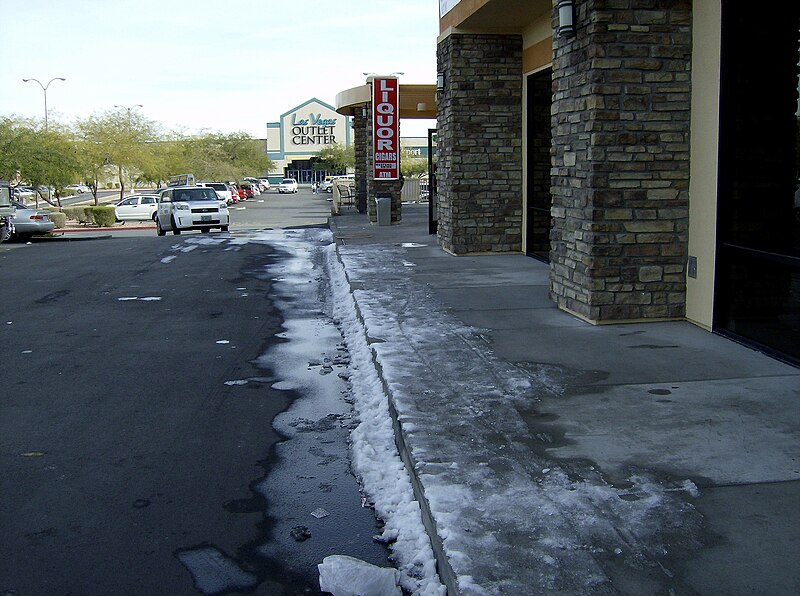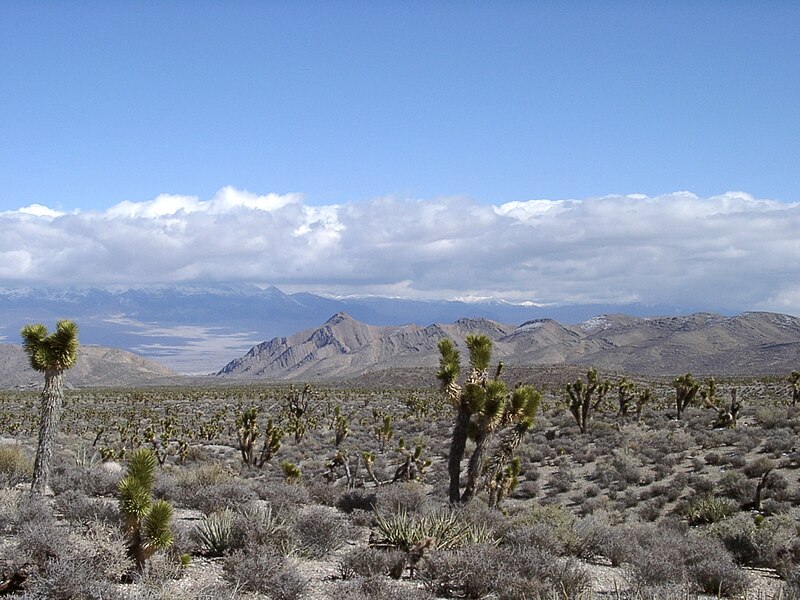 Las Vegas /lɑːs ˈveɪɡəs/ is the most populous city in Nevada, United States and the seat of Clark County. Las Vegas is an internationally renowned major resort city for gambling, shopping, and fine dining. The city bills itself as The Entertainment Capital of the World, and is famous for its casino resorts and associated entertainment. A growing retirement and family city, Las Vegas is the 28th-most populous city in the United States, with an estimated population by the U.S. Census Bureau of 583,756 as of 2010. The 2010 population estimate of the Las Vegas metropolitan area was 1,951,269.
Las Vegas /lɑːs ˈveɪɡəs/ is the most populous city in Nevada, United States and the seat of Clark County. Las Vegas is an internationally renowned major resort city for gambling, shopping, and fine dining. The city bills itself as The Entertainment Capital of the World, and is famous for its casino resorts and associated entertainment. A growing retirement and family city, Las Vegas is the 28th-most populous city in the United States, with an estimated population by the U.S. Census Bureau of 583,756 as of 2010. The 2010 population estimate of the Las Vegas metropolitan area was 1,951,269.Established in 1905, Las Vegas officially became a city in 1911. At the close of the 20th century, Las Vegas was the most populous American city founded in that century (a distinction held by Chicago in the 19th century). The city's tolerance for various forms of adult entertainment earned it the title of Sin City, and this image has made Las Vegas a popular setting for films and television programs. There are numerous outdoor lighting displays on Fremont Street, as well as elsewhere in the city.
The name Las Vegas is often applied to unincorporated areas that surround the city, especially the resort areas on and near the Las Vegas Strip. The 4.2 mi (6.8 km) stretch of Las Vegas Boulevard known as the Strip is mainly in the unincorporated communities of Paradise, Winchester, and Enterprise.
History
The first reported European visitor to the Las Vegas Valley was Raphael Rivera in 1829. Las Vegas was named by Spaniards in the Antonio Armijo party, who used the water in the area while heading north and west along the Old Spanish Trail from Texas. In the 19th century, areas of the valley contained artesian wells that supported extensive green areas or meadows (vegas in Spanish); hence the name Las Vegas.
John C. Frémont traveled into the Las Vegas Valley on May 3, 1844, while it was still part of Mexico. He was a leader of a group of scientists, scouts, and observers for the United States Army Corps of Engineers. On May 10, 1855, following annexation by the United States, Brigham Young assigned 30 missionaries of The Church of Jesus Christ of Latter-day Saints led by William Bringhurst to the area to convert the Paiute Indian population to Mormonism. A fort was built near the current downtown area that served as a stopover for travelers along the "Mormon Corridor" between Salt Lake and the briefly thriving colony of saints at San Bernardino, California. Mormons abandoned Las Vegas in 1857, during the Utah War. Las Vegas was established as a railroad town on May 15, 1905, when 110 acres (45 ha) owned by the San Pedro, Los Angeles and Salt Lake Railroad was auctioned off in what is now downtown Las Vegas. Among the railroad's most notable owners and directors were Montana Senator William A. Clark, Utah U.S. Senator Thomas Kearns, and R.C. Kerens of St. Louis. Las Vegas was part of Lincoln County until 1908, when it became part of the newly established Clark County. The St. Joan of Arc Catholic Church near 4th and Bridger in downtown was founded in 1910. Las Vegas became an incorporated city on March 16, 1911; Peter Buol was the first mayor.
Las Vegas started as a stopover on the pioneer trails to the west, and became a popular railroad town in the early 20th century. It was a staging point for mines in the surrounding area, especially those around the town of Bullfrog, that shipped goods to the rest of the country. With the proliferation of the railroads, Las Vegas became less important, but the completion of the nearby Hoover Dam in 1935 resulted in growth in the number of residents and increased tourism. The dam, located 30 mi (48 km) southeast of the city, formed Lake Mead, the US's largest man-made lake and reservoir. Today, tours are offered into lesser-known parts of the dam. The legalization of gambling in 1931 led to the advent of the casino hotels for which Las Vegas is famous. Major development occurred in the 1940s, "due almost entirely" to the influx of scientists and staff from the Manhattan Project, an atomic bomb research project of World War II. Atomic test watching parties were sometimes thrown. American organized crime figures such as Benjamin "Bugsy" Siegel and Meyer Lansky managed or funded most of the original large casinos. The rapid growth of Las Vegas is credited with dooming Galveston, Texas; Hot Springs, Arkansas; and other major gaming centers in the 1950s.
Climate
Las Vegas' climate is a subtropical desert climate (Koppen climate classification BWh), typical of the Mojave Desert in which it lies. The city enjoys abundant sunshine year-round: it has an average of about 300 sunny days per year with more than 3,800 hours of sunshine.
The summer months of June through September are very hot and mostly dry, with average daytime highs of 94 to 104 °F (34 to 40 °C) and night-time lows of 69–78 °F (21–26 °C). There are an average of 133 days per year above 90 °F (32 °C), and 72 days above 100 °F (38 °C), with most of the days in July and August exceeding that benchmark. Humidity is very low, often under 10%.
Las Vegas' winters are of short duration and the season is generally mild, with daytime highs near 60 °F (16 °C) and nighttime lows around 40 °F (4 °C). The mountains surrounding Las Vegas accumulate snow during the winter but snow is rare in the Las Vegas Valley itself.[14] Temperatures can sometimes drop to freezing 32 °F (0 °C) but winter nighttime temperatures will rarely dip below 30 °F (−1 °C).

Annual precipitation in Las Vegas is roughly 4.5 in (110 mm), which on average occurs on 29 days per year.Most of the precipitation falls in the winter, but the driest month (June) has only 2.9 fewer average days of precipitation than the wettest month (March).
Economy
The primary drivers of the Las Vegas economy are tourism, gaming, and conventions, which in turn feed the retail and restaurant industries.
Redevelopment

The Strip in late 2009
Astronaut photograph of Las Vegas at night
See also: List of tallest buildings in Las Vegas
When The Mirage opened in 1989, it started a trend of major resort development of the southern portion of the Las Vegas Strip outside of the city. This resulted in a drop in tourism in the downtown area, but many recent projects and condominium construction have increased the number of visitors to downtown.
An effort has been made by city officials to diversify the economy by attracting light manufacturing, banking, and other commercial interests. The lack of state individual and corporate income tax and very simple incorporation requirements have fostered the success of this effort.

With the Strip expansion in the 1990s, Downtown Las Vegas (which has maintained an old Las Vegas feel) began to suffer. The city made an effort to turn around the fortunes of downtown. The city successfully lured the Internal Revenue Service operations from western side of the city to a new downtown area building that opened in April 2005. The IRS move was expected to create a greater demand for additional businesses in the area, especially in the daytime hours. The Fremont Street Experience (FSE) was built in an effort to draw tourists back to the area, and has been popular. Since the recession began in 2008, many of these shops have closed. The multi-level Neonopolis closed their 11 theaters and nearly all retail stores. Many high-rise condo projects have been under construction, but one of the highest profile buildings, The Streamline Towers, went into bankruptcy.

The city purchased 61 acres (25 ha) of property from the Union Pacific Railroad in 1995 with the goal of creating something to draw more people to the downtown area. In 2004 Las Vegas Mayor Oscar Goodman announced plans for Symphony Park, which will include residential and office high-rises, the Lou Ruvo Brain Institute, an academic medical center, The Smith Center for the Performing Arts, and a new City Hall. After failed negotiations with The Related Co. on the development of Union Park in October 2005, San Diego-based Newland Communities was chosen by the city as the new development firm. The Newland contract calls for Dan Van Epp, Newland's regional vice president and former president of The Howard Hughes Corporation, to oversee his company's work on Symphony Park. The Lou Ruvo Brain Institute was completed in 2009.

In 2004 the city partnered with Cheetah Wireless Technologies and MeshNetwork to pilot a wide-area mobile broadband system. The pilot system is installed downtown, around the Fremont Street Experience. On a lot adjacent to the city's 61 acre site, the World Market Center opened in 2005. It was intended as a preeminent furniture wholesale showroom and marketplace to compete with the current furniture market capital of High Point, North Carolina.

On October 23, 2006, plans were unveiled to build a World Jewelry Center in Symphony Park. Similar to the World Market Center, the WJC will be a one stop shop for jewelry trade shows from around the world. The project proposes a 57-story, 815 ft (248 m) office tower. As of 2009 the project was still on hold.
Las Vegas decided to build a new city hall in the late 2000s. This had several consequences. One being that the Las Vegas Metropolitan Police Department, which shared city hall, would have to find a new location. The second being that the old building would be vacated with the potential negative impact on the downtown area. The police department elected to build a headquarters building in another part of the city and consolidate most of its operations in one place. This increased the departments presence with in the city since it would be moving in employees not presently working in the city. The second problem was address when the city and Zappos reached an agreement for Zappos to move its headquarters into the old city hall.

No comments:
Post a Comment